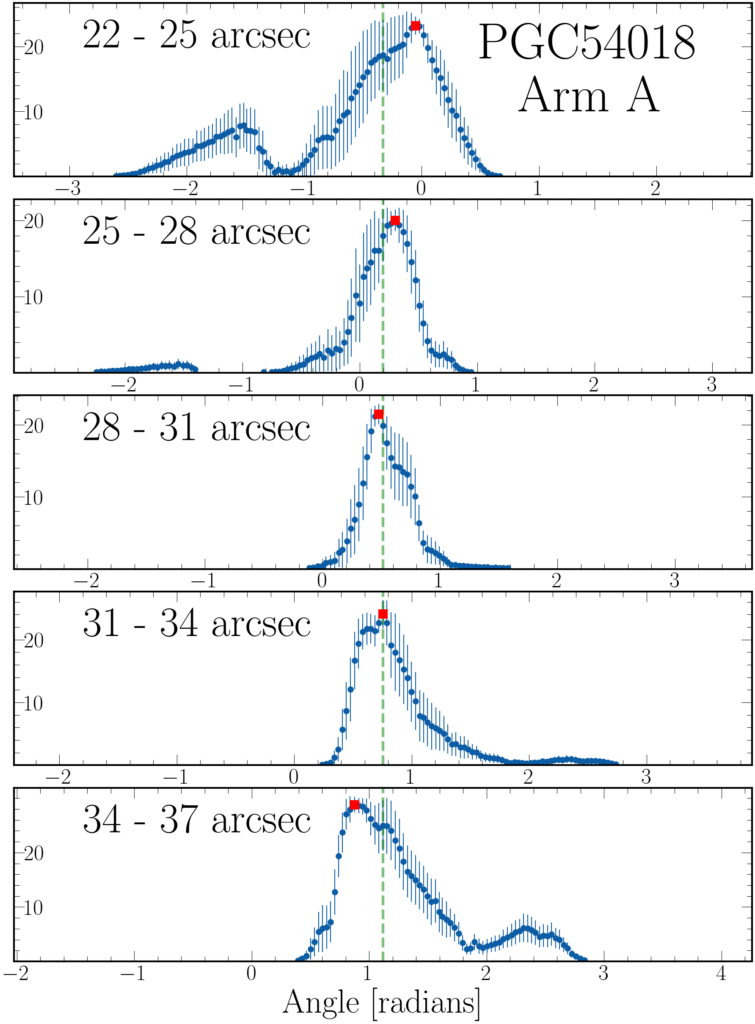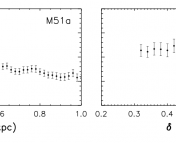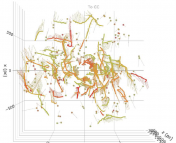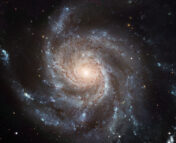Title: A new, purely photometric method for determination of resonance locations in spiral galaxies
Authors: Alexander A. Marchuk, Aleksandr V. Mosenkov, Ilia V. Chugunov, Valeria S. Kostiuk, Maria N. Skryabina, Vladimir P. Reshetnikov
First Author’s Institution: Central (Pulkovo) Astronomical Observatory, Russian Academy of Sciences, St. Petersburg, Russia
Status: Accepted to MNRAS Letters [open access]
Spiral galaxies are vicious, always trying to hide their secrets. But today’s authors found a new method to make them show their true colors.
Spirals Scheming and Plotting
Spiral galaxies show remarkable two-armed spirals. Naturally, researchers aim to explain how the galaxies create this beautiful form. This is still a matter of research, but there are already multiple possible explanations. One widely accepted theory explains the spirals by looking at stars that move on elliptical orbits around the galaxy’s central black hole. Because these elliptical orbits may precess, or change their orientation over time, they create overdensities of stars in the form of spiral structures, much like those pictured in Figure 1. This theory is called the density wave theory. Because everything is much more dense and dynamic within the spirals, these are also the places where star formation is boosted.

However, there can be more than one explanation for spirals, and even if one explanation is found to be true in one galaxy, there might be other galaxies with spiral arms caused by a different mechanism. So the task is to find a way to determine for an observed galaxy, which of the explanations is likeliest. Today’s authors focus on a way to determine whether the density wave theory applies.
Catch Those Spirals in the Act
According to the density wave theory, assuming the precession rate of each orbit is the same no matter at what distance, the spirals rotate with a constant speed. The stars, however, have a different speed depending on their distance to the center of the galaxy, due to the balance of gravitational and centrifugal force (which is called Keplerian motion). The Keplerian motion tells us that stars closer to the center are faster and stars further away are slower. How do the spirals then maintain a constant speed, you ask? This is because stars can enter and leave the overdensities, but the overdense areas are still there, similar to a traffic jam.
This concept, that spirals move at constant speed while the stars’ speeds depend on the distance, can be exploited in observations. It means that in the inner part of the galactic disk, the stars move faster than the spirals, and in the outer part the stars move slower. Therefore, there must be a location where the spirals move at the same speed as the stars. This location is called the corotation radius, or CR. The existence of a CR can be used as proof that the density wave theory is at work.
There are multiple ways to measure the CR in observed galaxies. However, many methods require the knowledge of additional parameters, such as the stars’ velocity or stellar ages. Those additional parameters can be observed, but the farther away a galaxy is, the harder it gets to acquire them. The authors of today’s paper developed a new method that only requires photometric data, i.e. a resolved image of the galaxy.
Got You Now, Crooked Spiral!

The new method by today’s authors makes use of the shape of the spiral along the arm. In the region close to the central black hole, the stars move faster than the spirals, which means that stars enter the spiral overdensity from behind the spiral and leave it in front. Vice versa, at the outer region, stars are slower than the spiral arm, so the spiral collects them in front and they leave the spiral at the back end. This causes the profile of the spiral to be skewed differently, as indicated in Figure 2 on the right side. Right at the CR, where the stars move at the same speed as the spiral, the profile is not skewed at all.

This means that by looking at the profile along the spiral arm, the CR can be determined as the point where the profile transitions from being skewed in one direction to the other. That’s great! Unfortunately, there’s a catch: it is difficult to measure the spiral profile, because there is a lot of noise in brightness due to the active star formation and hot and dense regions contaminating the photometric data. The authors of today’s paper make use of an existing study that retrieved the spiral profile by making multiple cuts across the spiral arms and then masking too bright areas. This reduces the noise caused by star formation. The authors of today’s paper apply their method to the retrieved profiles. One of the measured profiles is shown in Figure 3.
In order to test their newly developed method, the authors of today’s paper apply it to thirteen galaxies with known CRs. They find good agreement of their measured values with the values published in literature, and therefore argue that their method is robust and easy to apply, provided the spiral profiles are already extracted.
It’s Time for You to Spill the Beans, Spiral Galaxies!
Because the new method only relies on photometric data, it can be applied to very distant galaxies, if they are still spatially resolved. The authors of today’s paper apply their method to a sample of 102 galaxies with redshifts up to z = 0.9. This sample was evaluated for spiral profiles the same way as their test cases. In this sample, the authors could find the CR in 64 galaxies, whose CRs were not known before.
Knowing the CR in as many galaxies as possible helps to understand where the spirals might come from. Their new method contributes to the possibilities to determine the CR and promises bright prospects for future research.
Astrobite edited by Katherine Lee
Featured image credit: ESA/Hubble & NASA, Acknowledgement: Flickr user Det58; Staircase by Mitchell Luo on Unsplash





Note to the proof-reader: the section “Catch Those Spirals in the Act” is contained twice in the article (or more precisely one the paragraph above and the two following ones). 😉
Thank you very much for letting us know, I fixed it.